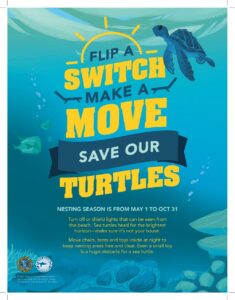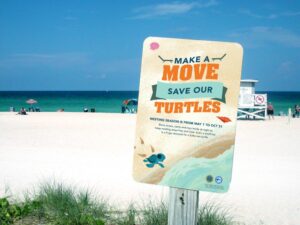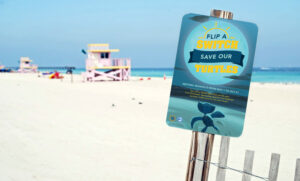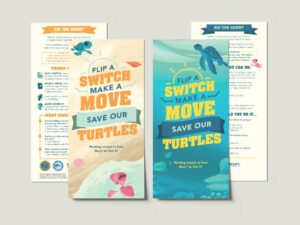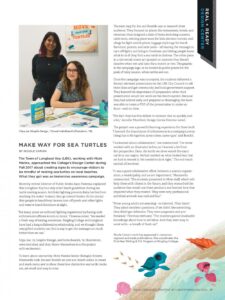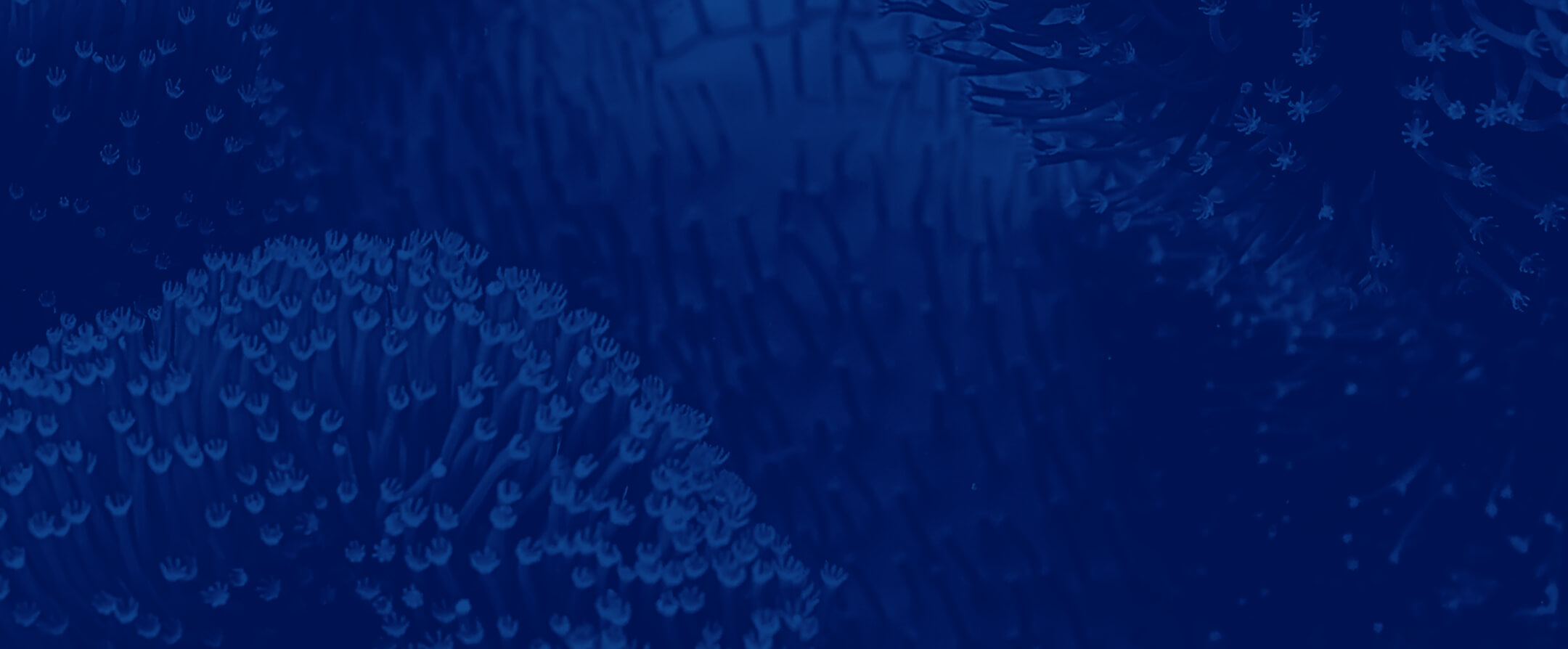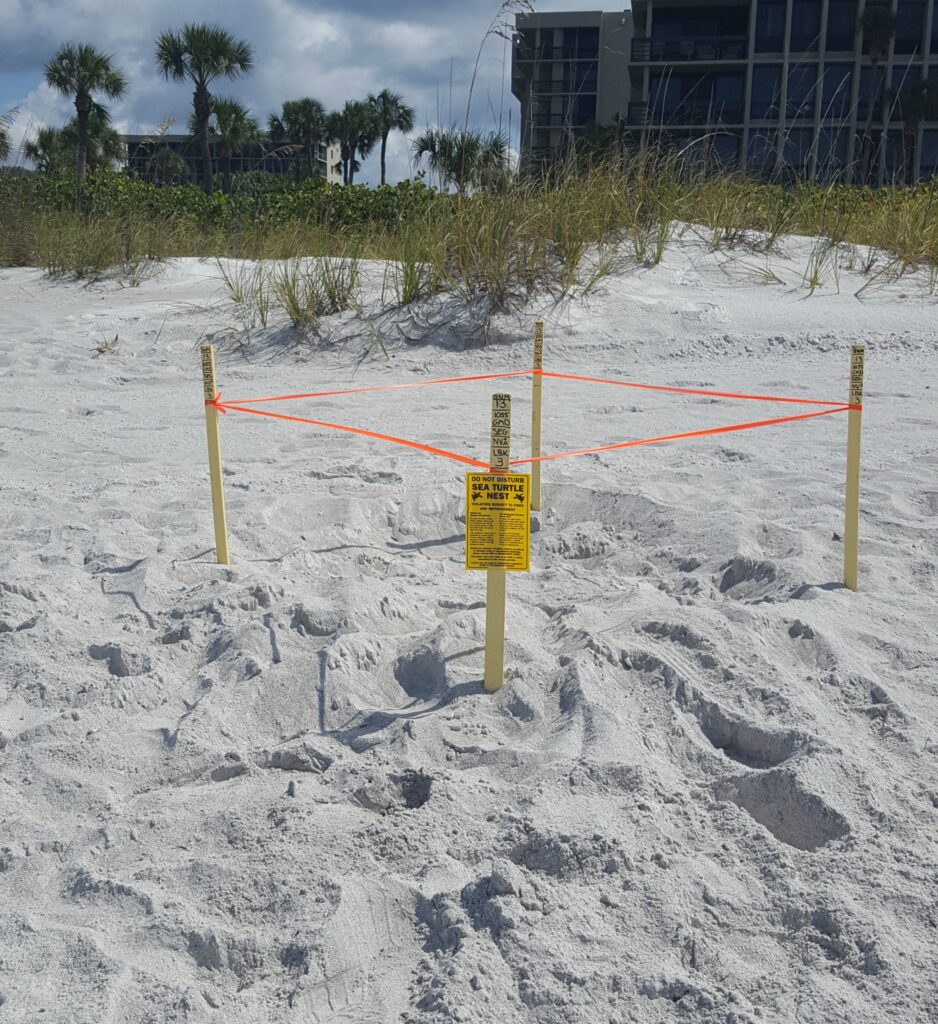The first local sea turtle nests of 2018 were discovered today by Mote Marine Laboratory’s Sea Turtle Patrol, a team of scientists, interns and approximately 300 volunteers who monitor nesting activity on Longboat Key through Venice every day of sea turtle nesting season, which officially runs from May 1-Oct. 31 in southwest Florida.
The first two nests — one on the Sarasota County portion and one on the Manatee County portion of Longboat Key — were laid by loggerhead sea turtles, a threatened species protected under federal law. Loggerheads are the most common species on southwest Florida nesting beaches, followed by threatened green sea turtles. In recent years, Sarasota County has also hosted a handful of endangered Kemp’s ridleys, among the smallest and rarest sea turtles.
“Nests were reported along the southern parts of our coast last week, so we were expecting our first local nest,” said Melissa Bernhard, senior biologist with Mote’s Sea Turtle Conservation and Research Program.
“We hope these nests will be the start of another successful nesting season.”
This year, Mote’s Sea Turtle Conservation and Research Program will continue its long-term studies of local sea turtles by documenting every sea turtle nest and false crawl (when a turtle emerges but does not leave a nest) in Mote’s patrol area, marking each nest with yellow stakes and flagging tape and collecting a suite of data.
Mote research has shown that nest numbers have increased recently on local beaches, with several record-breaking years in the past decade. In 2017 Mote reported 4,503 nests on Longboat Key through Venice — a near record-breaking year for Mote’s 36 years of Sea Turtle Patrol.
Starting Monday, May 7, the public will be able to view Mote’s weekly counts of sea turtle nests on Longboat Key through Venice.
With the potential for another busy year, it is critically important that the public supports sea turtle research and conservation. The public can help Mote, a non-profit, carry out this mission by donating online. Choose “Marine animal research and conservation” and type “sea turtle conservation and research” into the comment box.
“Now that we have identified our first nests of the season, we strongly urge beachgoers to enjoy our wonderful beaches, but also to be mindful of these sea turtles that are endangered and threatened species that have been nesting here for millions of years,” Bernhard said. “We want people to know they’re here and understand how to protect them by using turtle-friendly practices.”
This year, the Town of Longboat Key and Mote worked with Ringling College of Art & Design to create a cohesive awareness campaign promoting the town’s marine turtle protection ordinance. Ringling students, Silpa Joe and India Boeckh worked with Mote biologists to understand the hurdles faced by local nesting turtles and researched local outreach opportunities before creating posters, elevator clings, table tents, coasters, coloring place mats and luggage tags for beach furniture.
Tips for the public:
- During nesting season, it is important to keep local waters and beaches sea turtle friendly.
- Sea turtles are swimming just offshore to mate before the females come ashore to nest, juvenile turtles are feeding along the Gulf Coast, and by early summer the first hatchlings will venture into Gulf waters.
- On the nesting beaches, light from waterfront properties can disorient nesting female turtles and their young, which emerge at night and use dim natural light to find the sea. Also, beach furniture, trash and other obstacles can impede sea turtles and their young.
- Mote encourages coastal residents and visitors to follow the turtle-friendly tips below during nesting season, May 1-Oct. 31.
On shore
Do:
- If you encounter a nesting turtle or hatchlings, remain quiet and observe from a distance.
- Shield or turn off outdoor lights that are visible on the beach from May through October.
- Close drapes after dark and stack beach furniture at the dune line or, ideally, remove it from the beach.
- Fill in holes that may entrap hatchlings on their way to the water.
Do not:
- Approach nesting turtles or hatchlings, make noise, or shine lights at turtles.
- Use flashlights or fishing lamps on the beach.
- Encourage a turtle to move while nesting or pick up hatchlings that have emerged and are heading for the water.
- Use fireworks on the beach.
For more details, please refer to local sea turtle ordinances, including Sarasota County’s marine turtle protection code (which includes Lido, Siesta, Casey and Manasota Keys), the City of Venice marine turtle protection ordinance and the Town of Longboat Key marine turtle protection ordinance. An updated Longboat Key ordinance took effect in 2017. For questions about any sea turtle code or ordinance, contact code enforcement staff from each municipality.
On the water
- Follow Coast Guard-approved safe boating guidelines and use vigilance to avoid striking sea turtles and other large marine life.
- Be sure to stow trash and line when under way. Marine debris that accidentally blows overboard or out of a truck can become ingested by or entangled around marine life.
- Wear polarized sunglasses to better see marine life in your path.
- While viewing any large marine animals, follow 10 viewing tips (designed for dolphins, but suitable for other large marine species too). Click here for a PDF.
Emergency contacts:
If you see a sick, injured or stranded sea turtle, dolphin or whale in Sarasota or Manatee county waters, contact Mote’s Stranding Investigations Program at 888-345-2335. Outside of Sarasota or Manatee counties, please call the Florida Fish and Wildlife Conservation Commission (FWC) at 888-404-FWCC (3922).
If you suspect that someone is tampering with a sea turtle nest, harassing a sea turtle or has possession of a sea turtle or any of its parts, please call FWC, call your local sheriff’s department and/or call Mote’s Sea Turtle Conservation and Research Program at 941-388-4331.
If you find sea turtle hatchlings that are not on the beach or are headed away from the ocean, call Mote’s Sea Turtle Conservation and Research Program for instructions. Put rescued hatchlings into a bucket with a layer of damp (not watery) sand and cover the bucket with a towel. Do not put hatchlings in water or take them into air conditioning. Hatchlings heading towards the ocean should be left alone.
Sea turtles are protected under federal law and any harassment or interference with a sea turtle, living or dead, is subject to penalty.
